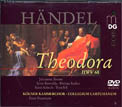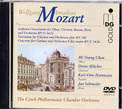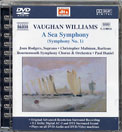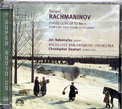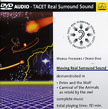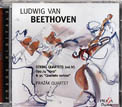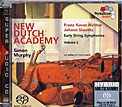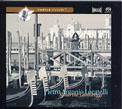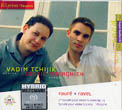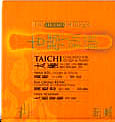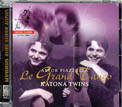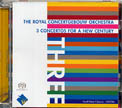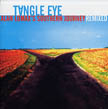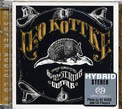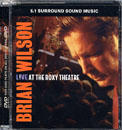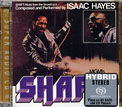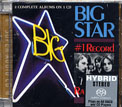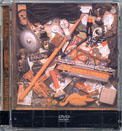|
You are reading the older HTML site Positive Feedback ISSUE 13may/june 2004
Hi-Res reviews featuring our friends from Audiophile Audition,
Part 2 June 2004 - Classical, Soundtracks, Pop, and more! DG Gold 2 + 2 + 2 DVD-A Reviews, Part 2
In the Jan/Feb issue of AUDIOPHILE AUDITION (and republished in Positive Feedback Online) I reviewed five of these alternate-surround-format DVD-As and had promised to do the rest the following month. Well, needless to say that didn't happen until this month. I thought I had four such specialized discs remaining but two of them turned out to be standard 5.1 DVD-As so here now are the two appropriate disc reviews finally. Here's a brief refresher in the special approach of this German label, Dabringhaus und Grimm: A widespread feeling among classical labels involved in multichannel hi-res is that the LFE channel or .1 channel is fine for movie tracks but not required for multichannel music. A smaller percentage also feel that the center front channel is fine for the dialog function of movie soundtracks but not needed for music—feeling the phantom center image can be created with more depth and realism by the left and right front speakers. (Nearly all of the producers of multichannel music in any form feel the 6.1 and 7.1 additional real-channel varieties are completely useless for music and in fact just a gimmick for movies too, but that's another discussion.) So labels such as Telarc, Chesky and DMP have used either the LFE channel or the center front channel or both for other purposes such as overhead speakers or high side/front speakers. These efforts have proved worthwhile but add complexity to the surround sound experience for the general public just getting used to the standard home theater 5.1 setup. Perhaps that is why there haven't been any more hi-res releases lately using these alternate approaches to surround for music. DG's Werner Dabringhaus espouses a different use of the two optional channels of the six. He says that while 5.1 broadens the horizontal perspective, his "2 + 2 + 2" system creates a truly three-dimensional listening perspective. He records with the usual compliment of mics for the left and right front and the left and right surrounds, but then he adds a pair of mics above each of the front lower pair, making a sort of rectangular four-channel pickup. For playback two additional speakers are mounted in line with the left and right front speakers but situated about half the distance above them of the distance the L and R speakers are separated from one another horizontally. The additional speakers can be smaller than the main frontal speakers and they should be toed outward so that there are reflections off the side walls (something like the bipolar surround speakers specified by Dolby and THX for movie soundtracks). The left high frontal speaker is fed the signal from the center channel and the right high speaker is fed the LFE signal. As you can imagine this requires quite a few radical changes for proper playback, besides getting the additional speakers and finding a workable way to suspend or mount them in line with the normal front speakers. The amp-to-speaker connections will have to be switched for each of the two channels, and if you are using a powered subwoofer for your LFE channel as most of us are doing, you will have to come up with an additional mono amp to power the top right speaker. Balances are also difficult to set because most of the six-channel setup-tone demos don't have the same pitch or sound in order to ID the LFE channel as with the other five channels. I set up a system with two switches to redirect the LFE channel output but still had to physically unplug my center channel speaker feed and substitute the lead going to the high left speaker. (By the way, each of these discs also has a standard 5.1 option in both DVD-A and DVD-V, plus stereo options in both.) HANDEL: Theodora (Dramatic Oratorio, in English) - Soloists/Cologne Chamber Choir Collegium Cartusianum/Peter Neumann conductor - DG Gold 2 + 2 + 2 six-channel DVD-A MDG 932 1019-5 (2 hrs. 36 min.) The single DVD-A comes in one of the large double-disc jewel boxes, leading one to believe there should be two discs inside for the two-and-one-half-hour oratorio. Not so—the large case is required for the thick booklet with its complete libretto translations, and the single disc holds the entire program since it is a DVD and not a CD with a limit of 80 minutes. The recording was made during a live concert in 2000 by the Cologne choir which is one of Germany's finest. Handel produced his sacred drama in 1749 in the original English and felt it was one of the best works he had ever created. The story originates in a legend from about 300 A.D. Theodora is a Christian of noble birth who has converted Roman officer Didymus to Christianity. The governor of the province decrees everyone must make sacrifices to the Roman gods on a special observance day. Theodora refuses and is put in a dungeon preparatory to her being forced into prostitution. Didymus changes clothing with her so she can escape; then he is arrested. Theodora returns to plead to the governor for him; she welcomes death rather than the alternative. The governor sentences them both to death. Curtain. Handel's choral writing is more vivid and colorful than in most of Messiah. The chorus as representing the heathen Roman population is accompanied by trombones, while when they represent the Christians they are accompanied by the string section. The rousing three-part overture is a fine little piece of orchestral Handel by itself. It demonstrated immediately the greatly expanded "sweet spot" offered by the 2 + 2 + 2 approach. I could even stand up and move around the room while enjoying a lively and almost holophonic frontal soundstage with depth and height. Then the first solo singer was heard and I almost jumped a bit, so realistically placed on stage was the voice. It sounded more solidly placed spatially and more naturally connected with its reflected sounds in the hall than I have heard in other hi-res opera and vocal recordings. The sense of some separation between the soloists, choir and orchestra was stronger than with most standard CDs and even better than most hi-res discs with similar forces involved. I had auditioned the first batch of 2 + 2 + 2 discs with a rather problematic DVD-A player, but had at hand the new Rotel 1050 for these two DG releases. I'm sure the improved fidelity of the newer player made my experience with these two DG discs even more positive. John Sunier
MOZART: Sinfonia Concertante for Oboe, Clarinet, Bassoon, Horn and Orchestra in E Flat Major KV C 14.01; Variations after KV 382 for Clarinet and Orchestra; Clarinet Concerto KV C 14.06 - Mi-young Chon, oboe; Dieter Klöcker, clarinet; Jan Schroeder, horn; Karl-Otto Hartmann, bassoon; The Czech Philharmonic Ch. Orch./Pavel Prantl - DG Gold 2+2+2 six-channel DVD-A MDG 901 1000-5 (60:26) Klöcker is a superb clarinetist whose interface with these three works is such that it sounds as if Mozart wrote them especially for him. There are some questions about both the authenticity and instrumentation of this Sinfonia Concertante, but it is a lovely half-hour-long work with a melodious Andantino with variations finale. The Clarinet Concerto has usually been heard as an oboe concerto, but Klöcker makes a case for his alternate reed instrument and the results are completely convincing. The little Rondo Variations KV 382 is heard here for the first time in a version acquired in the early 1900s by a clarinetist in St. Petersburg. Again, the great naturalness and three-dimensionality of the sounds on the frontal soundstage sets apart the 2+2+2 option from any 5.1, 5.0 or 4.0 hi-res disc I have heard. Some of the other alternatives employing the LFE and/or center channels have come rather close to this but no cigar. B-format Ambisonics—especially with a height-channel feed—can achieve a similar effect, but that approach seems to be ignored today in the face of the 5.1 channel juggernaut. John Sunier
VAUGHAN WILLIAMS: A Sea Symphony (Symphony No. 1) - Joan Rodgers, soprano; Christopher Maltman, baritone/Bournemouth Symphony Chorus & Orchestra/Paul Daniel - Naxos DVD-A 5.110016 VW pulled out all the stops in his very first symphonic effort, combining solo voices, chorus and orchestra in the sort of impressive work that even Mahler waiting until his second symphony to tackle. The texts are from Walt Whitman and deal with the many moods of the sea, comparing the journey of the voyager on the sea to the journey of the soul. They are in English and the lyrics are printed in the accompanying booklet. The score is more folk-influenced than some of his symphonies. The soloists are excellent and quite understandable without needing to always follow the libretto. This is another 44.1/16 bit multichannel effort. I believe something went wrong in the mix because the surround channels are so muffled and low in level that they sound almost as though the little sound there is leakage of signal from elsewhere. Switching to the DTS option - which Naxos now offers on most of their DVD-As—made no difference in the problem at all, and also sounded almost identical on the front channels. John Sunier
RACHMANINOFF: Piano Concerto No. 3; Rhapsody on a Theme of Paganini - Jon Nakamatsu, piano/Rochester Philharmonic Orchestra/Christopher Seaman - Harmonia mundi multichannel SACD HMU 807286 We seem to be having a rash of hi-res Rocky Thirds lately. It's surely one of the all-time thrilling piano concertos and so much better than the overplayed No. 2. And this new one is certainly in the running. Nakamatsu same out of the Tenth Van Cliburn competition and has been doing a lot of recording for HM, including all the Prokofiev piano sonatas. I still prefer the Volodos version on Sony Classical which I reviewed in May 2001 but it is only stereo SACD. Nakamatsu's piano is more normal-sized than the one on the Rocky 2 & 3 concertos on Naxos which I reviewed last month in the hi-res section (on both SACD & DVD-A simultaneously). Good for HM resisting the second concerto as the companion work here, but the Rhapsody is almost as much a chestnut. John Sunier
PROKOFIEV: Peter and the World; SAINT-SAENS: The Carnival of the Animals; JOSEF: Carnival Preparations - Soloists/Polish Chamber Philharmonic/Wojciech Rajski/Ladies Swing Quartet' Narrator of English version: Bradley Cole - Tacet multichannel DVD-A with Moving Real Surround Sound - DVD D114 Tacet has been doing some creative things with surround in their classical DVD-A releases. They usually place the players in chamber music one to a speaker, so that with a quintet, for example, you are completely in the middle of the ensemble as though you were one of the performers. Their next step was Moving Real Surround, which as the name suggests involves pan-potting some of the musicians around during the music. Tacet usually provides an alternate version of the music with the players stable, and the movement portions are carefully laid out, rather appropriate, and not outlandish. This time there is no space for nonmoving versions since there is narration involved in both pieces and two versions: one English and one German. Going thru everything twice, plus the breaks for narration, results in a DVD that times out at 151 minutes—double what would fit on one SACD or CD. Since more instruments are involved in both works they have to double up some at the five speakers. The oboe, second violin and trombone, for example, reside at the left frontal speaker. The percussion moves around as befits the story lines. A new script has been written for both works in which the owl is the storyteller. His voice does the most moving around the listening room, which I found eventually distracting. Kids might adore it, I wouldn't know. As Peter's story is told the various instruments occasionally move around. The oboe/duck waddles across the front soundstage to the pool from left to right; the bassoon/grandfather shuffles out of the house at the L surround area and towards the front. I thought an opportunity was missed by not having the final procession march around the listener to the music. There is more movement in the Carnival of the Animals, the most effective for me being the Swan swimming entirely around the listener. An interesting experiment in surround sound for certain. John Sunier
It's Beethoven for strings and for keyboard in our next pair of SACDs...
BEETHOVEN: String Quartets Vol. IV - Op. 74 "Harp" & Op. 95 "Quartetto serioso" - Prazak Quartet - Praga Digitals multichannel SACD PRD/DSD 250 199 The Prazak Quartet came out of Prague Conservatory and are based in that loveliest of Eastern European cities. They are one of the foremost ensembles specializing in the works of the Second Viennese School but also excel in the music of Czech composers. The recently completed recording all of the Beethoven Quartets and these are being gradually reissued as SACDs—this volume being the penultimate one. They have a clean, lean and precise approach which makes clear the complexities of these later Beethoven quartets. The Harp Quartet is contemporaneous with the Emperor concerto and shares a heroic tone in some sections. Op. 95 runs thru a gamut of emotional ups and downs, and shows a connection in its finale with Beethoven's Egmont Overture. My choice in the Beethoven Quartets has long been the Fine Arts Quartet, but their versions are now dated-sounding in view of the crystal-clarity of this new hi-res multichannel series. The players are spaced out in front of the listener, and although they don't completely surround one as with the Tacet DVD-As, the feeling approaches the excitement of being up on stage with them or actually having them playing for you in your listening room.
BEETHOVEN: The Last Three Piano Sonatas: No. 30 in E; No. 31 in A Flat; No. 32 in C Minor - Artur Pizarro, piano - Linn multichannel SACD CKD 225 Some of Beethoven's most original thinking is found in the last several of his 32 piano sonatas. Traditional movement structures are expanded, condensed or thrown out altogether. Theme and variations structures and the fugue sometimes replace sonata form. In No. 30, for example, no movements are where we would expect them—the middle movement is a two-minute Prestissimo and the closing movement a molto cantabile Andante at 11 minutes. The final sonata is only two movements: the first of relentless conflict and the final movement being a longish and sublime theme and variations. One of the variations seems to foreshadow 20th-century boogie-woogie in the bass line! Pizarro is dramatic and emotional in his delivery and the piano benefits from the natural reverberation of the Bristol church in which it was recorded. It is more distant-sounding than most piano recordings and perhaps due to that has a more natural size sonically. John Sunier
FRANZ XAVER RICHTER & JOHANN STAMITZ: Early String Symphonies, Vol. 2 - New Dutch Academy/Simon Murphy - PentaTone multichannel SACD 5186 029 We reviewed Vol. 1 in these series back in the Jan/Feb issue. All comments there apply here. There is just one Sinfonia a Quattro by Stamitz here, and three Sinfonias by Richter. The notes say this music of the Mannheim composers was "recorded at concerts and sessions"—not sure if that means an audience was present part of the time but not always. However if they were present they were extremely quiet, as European audiences often are. The 5.0 channel sound is involving and it finally corresponds to the name for the label (since their "RQR" series of SACDs were only four channel). If you are enjoying the first volume you will surely want to make this one part of your collection. John Sunier
PIETRO ANTONIO LOCATELLI: From "L'Arte del Violino, opera omnia III:" Concertos Nos. 11, 5 & 12 - Sandrine Cantoreggi, violin/Latvian Philharmonic Chamber Orchestra/Carlo Jans - Turtle Records multichannel SACD TRSA0018
Ms. Cantoreggi, who hails from
Luxembourg, plays a rare 18th century violin provided by the International
Bank of Luxembourg. She has selected for her program three illustrative
concertos from a set of 12 concertos and 24 caprices by the
17th/18th-century violin virtuoso/composer Locatelli.He performed all the
noted Italian composers of the time but broke some new grounds with his
collection The Art of the Violin. No one before him had advanced the
virtuosity quite as far nor explored the highest reaches of the instrument's
pitch range. His imagination and innovation was unique and Cantoreggi
obviously feels in perfect tune with his music. Locatelli's spirit inspired
the virtuoso violinist/composer Paganini a whole century later. The three
concertos are all in three movements with the middle being the Largo or
Adagio movement. This is not just more of the same Vivaldi or Corelli;
Locatelli in this violinist's hands is something very special. I found this
the most enjoyable Baroque program I have heard in ages, and the detailed
sonics and surround acoustics don't hurt the impression a bit.
FAURE: Sonata No. 1 for Violin and Piano; RAVEL: Sonata for Violin and Piano; Tzigane - Vadim Tchijik, violin/Cedric Tiberghien, piano - Lyrinx multichannel SACD LYR 2223 These young performers have chosen a pair of violin-piano sonatas which have been disc-mates before and account very well for themselves. The early Faure work is the only piece of chamber music the composer ever wrote in a major key. It shows the generally gentle demeanor of Faure. Ravel's sonata aroused consternation early on for its use of jazz in the middle movement—a blues played pizzicato with the piano hammering out chords. His Tzigane makes for a smashing finale with its wild improvised-sounding violin tricks. Lovely violin tone, as on most hi-res recordings. I recall that even with its serious faults the first 44.1 CDs seemed to excel with piano recordings. Well, now I think the instrument that benefits most from both hi-res formats is the violin. No more string digititus! First rate multichannel, with the surrounds providing mostly ambience of the hall. John Sunier
The Legend of Guqin = NAI-CHUNG KUAN: Tai Chi Concerto for Guqin & Piano; Phoenix Hairpin; Guangling Episode; 18 passages of the Hu Jia - 1st Passage; Flowing Water; Moon Over Mountain; Triple Thematic Statement of Plum Blossoms; 18 Passages of the Hu Jia - the 9th Passage; Singing Plum - Shan Kiu, guqin & vocals/Lucas Wong, piano/Daya Academy Ensemble/Nai-Chung Kuan cond. - FIM multichannel SACD M 054 The unusual packaging of this album is an indication of the unique sounds and information to found inside. The notes are in both English and Chinese. The Guqin is one of the most ancient musical instruments in the world and central to the culture of China. It looks something like a simpler koto and the instruments heard on these recordings come from the Yuan and Ming Dynastys (as early as 1280 AD). The recording sessions were held in Vancouver, BC and recorded directly to both 8-track DSD with the Sonoma system and to 8-track analog on 1/2-inch tape. The opening Tai Chi Concerto is the major work here and full of fascinating sounds as the guqin and piano converse and exchange with the other performers of the ensemble. There are some vocals, sung by guqin virtuoso Kiu in a style known as guqin singing. The ancient melody Flowing Water is played as an unaccompanied guqin solo. All nine selections are lovely, exotic to Western ears but still very accessible nevertheless. The multichannel recording is demonstration quality. It is apparent a great deal of loving attention to detail went into the entire production from start to finish. I hope, as do the album's producers, that the project reaches out in the process of creating harmony between the cultures of East and West, as it clearly does on the musical plane. John Sunier
LE GRAND TANGO - Music of ASTOR PIAZZOLLA: Fugata; Otono Porteno; Milonga en re; Tango Suite; Tres Minutos con la Realidad; Homenaje a Lieja; Le Grand Tango - The Katona Twins, guitars, with Alfredo Marcucci, bandoneon; Daniel Storer, doublebass; Carducci String Quartet - Channel Classics multichannel SACD CCS SA 19804 This appears to be the fourth album the talented guitar duo has made for Channel Classics. If they recorded only works Piazzolla had penned for two guitars their album would be very brief—the only he wrote is the three-movement Tang Suite heard here. So transcriptions are the rule. Piazzolla nearly always included a guitar of some sort in his ensembles, so he saw it being as integral to the spirit of instrumental tango as the bandoneon, and it made the transcribing easier for Peter and Zoltan—who did all the arrangements themselves. the opening Fugata is for the two guitars plus string quartet and doublebass. Homage to Lieja was originally a concerto for bandoneon, guitar and strings. Le Grand Tango was written for cellist Mtislav Rostropovitch with piano accompaniment; it has also been performed by Yo-Yo Ma. This is an altogether delectable concert of Piazzolla chamber-tangos, and in exemplary hi-res sonics. The only thing that didn't quite work was the cover photo art—it's evidently intended to be a blurry image of Piazzolla or at least a bandoneon player, but it doesn't quite register and reminded me of those "ghost" photographs. John Sunier
Three Concertos for a New Century - the Royal Concertgebouw Orchestra = GEERT VAN KEULEN: Horn Concerto; THEO LOEVENDIE: Clarinet Concerto; WILLEM JETHS: Flugelhorn Concerto - NorthWest Classics Stereo SACD 109206 All three of these are newly-composed works. Jacob Slagter is the soloist in the horn concerto and David Robertson the conductor. The work is in three movements with the first and last being the slow movements. Loevendie was part of the Amsterdam jazz scene before he turned to writing concert music and his Clarinet Concerto shows it. I found it the most interesting of the three concertos here. George Pieterson is the clarinetist and Ingo Metzmacher the conductor. At 22 minutes the concerto for Flugelhorn is the major work of the three. Composer Jeths is also a musicologist. Soloist here is Peter Masseurs and Markus Stenz is the conductor. This concerto also has some jazzy references but perhaps they are more due to the familiar timbre of the Flugelhorn in jazz than quotations in the music. The album was recorded direct to DSD for best sonic quality. John Sunier
Tangle Eye – Alan Lomax's Southern Journey Remixed; CD This disc is an exploration into new music created by sampling Alan Lomax's recordings from 1947-1960 and scoring modern music to them. Lomax's recordings have been used more recently in films like O Brother, Where Art Thou? and The General's Daughter. The excerpts are mostly a cappella performances ripe with emotion that take place in a natural setting. Track 3 is reincarnated as a techno blues march which, although sounding a bit strange at first, actually works. Track 5 is a funky tune like something from Greyboy. Track 7 is a chant complete with psuedo-tribal drumbeats pounding in the background. Each song is reinvented in a unique way or another that breathes new life into these wonderful old recordings. Track 8 is reggae and 11 is preceded by a classical/church-style organ intro—it seems that no genre is safe from New Orleans-based Tangle Eye. This CD is just plain interesting. I tend to like new interpretations of older music (when they're well done) and this disc shows how it can be done most successfully. Songs included are: John Henry's Blues; Drowned; Heaven; Home; Parchman Blues; Holler; O Death; Chantey; Hangman; Work Song; Soldier Intro; Soldier. Brian Bloom
Leo Kottke – 6- And 12-String Guitar; Takoma TSA-6503-6 Hybrid Stereo SACD Yee-haw! The fact that Kottke was only 24 years old in 1969 when this record came out makes the performance even more impressive. His finger-style guitar playing has elevated him to the level of fingerpicking icon drawing the respect of musicians of all genres. Thank heavens that the person responsible for making this recording knew exactly what they were doing. The guitar produces a sound that is larger than life, and overall, the sound quality clearly surpasses that of the best CDs. It was fun to pick out each of the individual guitar plucks and I was constantly amazed at the trueness of the tone. It is hard not to become mesmerized by Kottke's pure talent. The songs are primarily composed by the artist and cover a range of different musical genres. Any student of the guitar should be impressed by the range of sound possible on the instrument demonstrated by this recording. The melodies are beautiful, the pace is just right, and you'll want to listen to the disc over and over. Listening to this SACD is like hearing a solo guitar concert in your home—what a treat! Songs included are: The Driving Of The Year Nail; The Last Of The Arkansas Greyhounds; Ojo; Crow river Waltz; The Sailor's Grave On The Prairie; Vaseline Machine Gun; Jack Fig; Watermelon; Jesu, Joy Of Man's Desiring; The Fisherman; The Tennessee Toad; Busted Bicycle; The Brain Of The Purple Mountain; Coolidge Rising. Brian Bloom
Brian Wilson – Live At the Roxy Theatre; Rhino R9 73928 DVD-A This performance was recorded on April 7 & 8, 2000 at Los Angeles' Roxy Theatre and was remixed in 5.1 by Mark Linett. Short songs aren't always a benefit, but in the case of this disc it means 30 tracks! Stills play over the music and the multichannel mix helped to create greater immersion in the concert environment. I'm sure the big question on most people's mind is: What is the state of Brian Wilson? Let me just say…he's seen better days. Much of the singing sounds like he's had a few too many. Just imagine you're at your local pub and a guy who's had a few decides to sing. He's not quite slurring heavily, but he isn't too far off. If this were the gong show, then I'm not sure if Wilson would make it to the end—but it would be close. The chorus that accompanies Wilson is decent, although the performance is not up to the level of the original recordings. For the price of admission you do get a good sampling of Beach Boys tunes and solo work as well. I have no doubt that you are getting a realistic portrayal of Brian Wilson in concert, but some may find that these days, that is disappointing. This disc contains both a high-resolution multichannel mix as well as a stereo mix. There is an interview with Wilson that sheds some light on why's and how's of the performance—you even get some bonus singing and piano. Some of the topics include a discussion of the song selections and what its like to play after being a stranger to the music circuit. Also available is a photo gallery and liner notes. Songs included are: Little Girl Intro; The Little Girl I Once Knew; This Whole World; don't Worry Baby; Kiss Me Baby; Do It Again; California Girls; I Get Around; Back Home; In My Room; Surfer Girl; The first Time; This Isn't Love; Add Some Music To Your Day; Please Let Me Wonder; Band Intro; Brian Wilson; ‘Til I Die; Darlin'; Let's Go Away For Awhile; Pet Sounds; God Only Knows; Lay Down Burdon; Be My Baby; Good Vibrations; Caroline No; All Summer Long; Love & Mercy; Sloop John B; Barbara Ann. Brian Bloom
T. Rex – Electric Warrior - Rhino R9 76111 DVD-A According to the press release, T. Rex was one of the hottest British bands of its time and spearheaded the glam-rock movement. Marc Bolan, the headmaster of the band met with an early demise and extinguished what might have been a long, successful music career for the band, although further releases did not have the same spark as Electric Warrior. The original producer of the album, Tony Visconti, remastered this disc and perhaps for that reason, this is one of the more masterful jobs. Occasionally there are instruments purposefully placed in the surround channels, and in the insert there is a page devoted to the ideas behind the transformation to multichannel. The booklet also has in depth explanations of each song on this record. There is quite a bit of good material on this classic album even though some may not have been too familiar with the music. Although the album hit number 1 in the U.K., in the states there was some confusion about the classification of the music that led to less playing time. Still, the album managed to hit #32 on the charts. The heavy, thick quality in the vocals and T. Rex's groovy electric guitar is unmistakable. A lot of the tunes are guitar driven and are mostly mellow. While many 70s rock bands leaned toward a country/western influence, T. Rex is much more blues oriented. "The Motivator" is a particularly good tune and if it wasn't a hit, it should have been. There is an on-screen picture gallery and the choice of lyrics or stills over the music. The disc has the option of a hi-res stereo track too. And don't forget to check out the vintage video of T. Rex's most popular song, "Bang A Gong (Get It On)"—you just might recognize a well-known pianist manning the ivories. Songs included are: Mambo Sun; Cosmic Dancer; Jeepster; Monolith; Lean Woman Blues; Bang A Gong (Get It On); Planet Queen; Girl; The Motivator; Life's A Gas; Rip Off. Brian Bloom
Isaac Hayes – Shaft; Stax SXSA-88002-6 Hybrid Stereo SACD This disc includes music from the soundtrack of the breakout film, Shaft, a story of a black private eye trying to stay alive and on top of things in Harlem. Hayes had a hit single with the theme song and won an Oscar. The album stayed at the top of the charts, won a Grammy, and was one of the best-selling soundtracks ever. Hayes played keyboards, vibes, and did the singing, while Johnny Allen arranged the music. The success of this record helped to pave the way for other R&B artists like Curtis Mayfield and Marvin Gaye to supply music for film. Stax is really putting out some good SACDs, but this album was even more of a surprise. Shame on me for not already having it in my music collection! The sound quality of the disc is very good and the music is great. It's easy to forget how many good soundtrack records came out of movies in the 70s. The songs are soulful, funky, and hot! Just buy it. Can you dig it? Songs included are: Theme From Shaft; Bumpy's Lament; Walk From Regio's; Ellie's Love Theme; Shaft's Cab Ride; Café Regio's; Early Sunday Morning; Be Yourself; A Friend's Place; Soulsville; No Name Bar; Bumpy's blues; Shaft Strikes Again; Do Your Thing; The End Theme. Brian Bloom
Big Star – #1 Record and Radio City; Stax SXSA-60025-6 Hybrid Stereo SACD Big Star is credited with defining the musical genre known as power pop. Power pop is described as "a style in which bright melodies and tunefully boyish vocals are propelled by urgent rhythms." This release is a single disc combining two albums that were a couple of years apart in the early 70s and contained the band's best material. Regardless of their historical influence to the power pop genre, my first impressions were of bright, wiry sounding vocals that beckoning me to turn the volume down—eventually I succumbed. I've actually seen this release on some people's best of lists, or at least their lists of influential recordings. The latter might be more appropriate, because some of the material sounded downright amateurish. I have to admit that some of the songs do sound reminiscent of bands like The Hollies, Led Zeppelin, and other bands that dominated the charts in the mid to late 70s and early 80s. This music does manage to predate them in terms of this particular type of material. You might even recognize some of the tunes that are played in the television program "That 70s Show." I thought that by track 4 the quality of the sound had improved greatly, but unfortunately it went right back to sounding slightly harsh with overemphasized treble. The "boyish" vocals almost always seemed out of tune to me and bordered on irritation depending on the song. The second album is more rocking and has a harder guitar sound. I found it to have more impact as a whole. Track 17 particularly could be released today and probably do well. "September Gurls" seemed like it was before its time, so maybe there is something to the belief that the band did have a large influence on later artists. Songs included are: Feel; The Ballad Of El Goodo; In The Street; Thirteen; Don't Lie To Me; The India Song; When My Baby's Beside Me; My Life Is Right; Give Me Another Chance; Try Again; Watch The Sunrise; St 100/6; O My Soul; Life Is White; Way Out West; What's Going Ahn; You Get What You Deserve; Mod Lang; Back Of Car; Daisy Glaze; She's A Mover; September Gurls; Morpha Too; I'm In Love With A Girl. Brian Bloom
Katinka Wilson – One Life; Opus 3 CD 22032 Hybrid Stereo/Multichannel SACD This disc only uses the surround channels in a very subtle way, and there is no center channel either when listening to the multichannel track. Considering the fact that this is a debut record from Wilson, a gifted singer/songwriter, it is pretty good. The recording is clearly audiophile oriented and the recording equipment is listed in the booklet accompanying the CD like many of the audiophile labels. The environment lends itself to a very wet presentation with unusual ease. It appears there was great care taken to ensure a natural quality to the sound. The music could be described as adult contemporary and not unlike some of the material from Jennifer Warnes. The saxophone and backing instruments help to contribute to the easy, relaxing feeling I got while listening to the record. Wilson has a sensual, rich voice that still manages to convey a sense of vulnerability and I'm reminded of Rebecca Pidgeon, Rickie Lee Jones, and some of the other Chesky artists. From the first couple of songs the listener will get the vibe, and then it's up to them to decide whether it is appealing or not. With a little more variety and "oomph" Wilson will graduate from what I would call "sonic wallpaper" to the level of someone like Norah Jones or Diana Krall, albeit with a different style. The music is relaxing, but just not all that involving--It's sure to become an audiophile favorite. Songs included are: Why; Did You Fly; The Boat; Bottomline; One Life; ‘Cause I Miss You; Heather; El Morte; Sounds; The Puppet; Grey Dressed Skies; Razor Blade Jane. Brian Bloom
Swag – Catch All; Hi-Res Music HRM 2016 DVD-A This disc is recorded in stereo and the sound quality is similar to a good CD on most of the songs. Swag is a four piece rock band with an alternative flavor that reminds me a little of Collective Soul while still remaining unique. Track 3 is a soft love song with better fidelity than some of the others and is all acoustic and includes a harmonica. The music style is varied although the quality is consistent. The singer reminded me a great deal of the vocalist in the band Jellyfish, though they are not the same person. Most of the music on this disc is lighthearted and lively. Songs like track 4, 7, and 12 sound very much inspired by the Beatles and may have value to the listener for this reason alone—listen to track 7 especially. When all was said and done I wasn't sure if I liked this disc or not. You'll probably just have to listen for yourself and see what you think. Album art is an extra, and only the song title is displayed while the music plays. Songs included are: Lone; I'll Get By; Near Perfect Smile; Please Don't Tell Her; When She Awoke; Louise; Different Girls; You; Eight; Dear Trixie; Ride She's Deceiving. Brian Bloom Reviews reprinted with permission from Audiophile Audition
|


